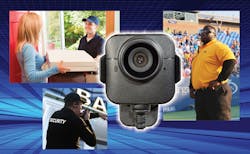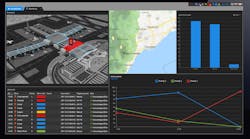Emerging Applications for Body-Worn Cameras
As I walked the aisles at the recent ASIS Global Security Exchange (GSX) event in Chicago, I noticed how many camera and video management software vendors were touting business applications for mobile and body-worn cameras. This should be quite appealing to security integrators, especially one that has a strong recurring revenue component.
Body worn cameras (BWC) for policing have seen a rapid global adoption rate unlike any other public agency technology adoption; in fact, there are now more than 60 different body worn cameras produced specifically for law enforcement use.
Lessons learned from police BWC adoption can provide valuable insights and perspectives to security consultants and integrators who service cities and counties, businesses and citizen groups such homeowner associations and neighborhood watches. In addition, many of these lessons apply to emerging non-security applications – business functions – for mobile video and body worn cameras.
5 Lessons Learned from BWC Use
As mobile and BWC video usage increases, there have been five lessons learned for security integrators and their customers hoping to deploy the technology:
1. Do not shortchange camera and video capabilities for budgetary reasons. It is better to have fewer applications with full video capabilities – i.e. no gaps in coverage and no feature shortcomings in live and recorded video management applications – than to have a larger deployment that cannot live up to expectations. It is better to start smaller with full capabilities, because that success can be used to justify an expanded deployment. Sometimes that means a pilot project, with progressive expansion; other times it means covering the most critical areas or personnel first.
2. Do a thorough job educating video-use and funding stakeholders to keep expectations real. It is important to realistically set the expectations of all stakeholders, and not let others do it by default – such as via media coverage and vendor literature. Lost confidence among stakeholders can be very hard to regain, compromising security, safety or business results that otherwise could have been achieved.
3. Develop a realistic deployment and initial results timeline. For this you must consult with both vendors and the end-users. What is the technology learning curve? What steps do existing customers wish they had included in their acceptance testing? How long can it take to work out all the kinks regarding how the system is used? What levels of staffing and skill were required at what points in the deployment? How long did it take before they could report fully meeting their deployment’s objectives?
4. Fully account for privacy and regulatory concerns. While the vast majority of citizens surveyed – including arrestees – were in favor of police BWC usage, some cite privacy concerns, mostly about video taken inside an arrestee’s home and especially without notification of the videoing. Austria assessed a General Data Protection Regulation (GDPR) fine of €4,800 (about $5,400) in October 2018 to an entrepreneur whose establishment had a surveillance camera that captured a large part of the sidewalk in front of the business. There were two violation points about the surveillance – GDPR forbids large-scale monitoring of public spaces without a sufficient public interest reason, but additionally, appropriate signage about video surveillance was lacking. Most business applications do not have such privacy or regulatory concerns, but in some vertical markets, they do.
5. Consider video subject usage concerns. By policy and supervised practice, ensure that video coverage extends from first arrival on-scene to departure – whether it is the customer or client arriving or departing, or if it is company personnel. Partial incident video coverage is the single largest complaint about BWC usage, because turning recording on or off was at the discretion of the officer.
Additionally, in customer service situations, for example, a disagreement can arise about what has been said or done, and partial transaction video coverage will not resolve the situation.
The police practice of discretionary officer video activation was originally motivated by insufficient camera battery life. With today’s technology, battery life should not be a concern. Another lesson is that if multiple individuals are interacting with a subject, all individuals should have BWCs actively recording to eliminate concerns over off-camera activity being undocumented. It only takes one aspect of an encounter to be unrecorded to allow a dispute to arise that relates to potential organizational liability.
Emerging Applications for Body Cameras
Areas where mobile and BWC video are proving to be of value include: Operations safety, customer service, personnel training, policy and procedure compliance, and security officer interactions and patrols. All of them present compelling reasons for integrators to expand into becoming a provider of body-worn and mobile video.
Operations safety: Mobile vehicle cameras, such as one 360° or two 180° cameras, can provide full surroundings visual coverage, while a body-worn camera can record the audio and video of what a vehicle operator sees and hears. It can be infeasible to provide 100% coverage of large-scale outdoor areas, such as for oil and gas processing facilities, mining operations, electric utility, water utility, and amusement parks sites; however, it can be feasible to provide vehicles with mobile video coverage and security/safety/supervisory personnel with body-worn cameras. To help prove ROI on this type of investment for customers, note that implementing such video coverage can favorably influence liability insurance rates.
Customer service: Audio-enabled video recordings have long been used to verify the effectiveness of training for retail point-of-sale transactions. BWCs can now extend that practice in valuable ways. For example, a pizza-chain franchise operation implemented cloud-VMS-recorded BWCs for its delivery personnel to ensure that delivery problems were fully documented. As it turned out, the business’s executives discovered that the most valuable result was a significant improvement in attitudes of delivery personnel and more positive customer interactions – as proven by an increase in sales.
Personnel training: Using BWCs to record how something should be done correctly – and even to document the results of incorrect actions – can be much more effective for training than explanations or written materials. It is usually easier, faster and more effective to update video material for changes to procedures, practices, tools or equipment than it is to update and distribute printed material.
Policy and procedure compliance: Sales of funeral services and cemetery plots, as well as real estate sales, have regulatory requirements regarding disclosures as well as mandated and forbidden practices. BWC video can be reviewed after the fact for compliance to regulatory requirements; however, in the near future, AI-enabled real-time BWC audio analysis can track whether required statements are made, and even monitor for forbidden statements, prompting the salesperson by text message regarding the compliance issue. This kind of application was brought up by an attendee at a GSX panel session I attended, who said he had a client requesting it.
Security officer interactions: This has been the most commonly discussed use of corporate BWCs over the past several years. Hospital security personnel – often the first responders for many types of personnel-at-risk situations – have used body-worn cameras for several years, where patients and healthcare personnel can both be at risk. BWCs are being implemented for sports stadium and other event venues that have high attendance and whose security personnel have responsibilities for crowd management as well as attendee misconduct and confrontational situation control.
Security officer patrols: BWCs facilitate officer documentation of non-conforming facility conditions during patrols and premises inspections. Trash on stairwells, for example, can be noted in the officer’s log, with the video capturing the exact circumstance. If the situation poses a safety or health risk and warrants the officer performing immediate correction, the video can be used afterwards to support appropriate corrective and preventive actions.
Reducing corporate liability: For business office situations that pose risk of hostile actions – such as escorting a terminated employee from the premises – a BWC can help keep a lid on the situation as the informed employee knows there will be recorded evidence of any hostile actions or non-compliance. The use of BWCs typically keeps the behavior of security personnel at their best, and thus has multiple positive influences on reducing corporate liability in potentially confrontational situations.
Most of these business, safety and security uses of BWCs require use-case scenarios to address the system’s requirements. For example, if customer service or field service technicians can be subject to duress situations, then such use-cases may warrant a BWC requirement for a camera-based duress button that can signal a central monitoring center or trigger a text message to personnel who can assist. Many BWC systems have such duress buttons.
BWC Integration with VMS
To date most police-intended BWC systems have been expensive and were not designed for integration into a business video management system (VMS); in fact, most BWC systems have been standalone systems, with some having the ability to export recorded video for importation into a VMS.
This is changing, as three VMS companies in 2018 added support for body-worn camera systems to their VMS products.
Milestone Systems added support in XProtect for live streaming low-resolution video images for live monitoring, while high-resolution video is stored in the Edesix or Zepcam partner BWC back-end server system. Later, when the body-worn camera is connected to a higher bandwidth network, the recording on the device will be transferred to the VMS and synchronized with the recording sent in real-time – enabled by ONVIF profile G. The Zepcam cameras support 3G, 4G and WiFi video transmission, while the Zepcam back-end server can be premises-based or cloud-hosted.
Genetec integrated Security Center with its vehicle-based AutoVu license plate recognition (ALPR) system that automates license plate reading and identification, making it easier for law enforcement and for municipal and commercial organizations to locate vehicles of interest and enforce parking restrictions. With a press of a button on a body-worn camera, a parking enforcement officer or commercial parking organization personnel can trigger a video recording, and the ALPR ties video clips to ALPR metadata such as plate reads, GPS coordinates and timestamps. When video evidence from body-worn cameras needs to be retrieved, users can search based on plate number, time range or by using maps. Redundant archiving and failover are not supported when using body-worn cameras. Security Center supports Edesix and Zepcam BWC systems, including low-resolution live streaming of video from the Zepcam server via the ONVIF protocol.
Eagle Eye Networks introduced support for Hikvision body-worn camera video in April 2018 with the same cybersecure VMS capabilities and triple-redundant storage for any specified time period, just as for fixed and mobile surveillance video. At the end of a work shift, personnel place their mobile or body-worn camera in a Hikvision docking station, and the Eagle Eye Bridge appliance automatically accesses the storage on the camera and uploads the timestamped video to the cloud along with its GPS metadata. No further human action is required.
In 2019, Eagle Eye expanded its BWC support to include 15 additional third-party mobile and body-worn cameras. The cloud approach is subscription-based, enabling the addition of mobile or body-worn cameras to existing on-premises Eagle Eye Bridge buffering or recording devices simply by connecting the docking station to the Camera LAN port on the appliance and expanding the subscription to match the new camera count.
Small- and medium-sized businesses – including those with multiple sites – are easily supported because the cloud-based approach eliminates the need for on-premises recording and video management servers, and video is available via PC workstations or mobile devices to authorized subscriber personnel. The bridge appliances that buffer incoming video are cloud-managed, including automatic security and feature updates. No IT skills or contracted services are required to maintain the simple on-site equipment. With a low initial setup cost and roughly $12-15 per month per camera for Full HD (1080p) mobile or body-worn cameras, the cloud-based VMS approach can be affordable for businesses or citizen groups that have mobile and body-worn camera needs.
Ray Bernard, PSP CHS-III, is the principal consultant for Ray Bernard Consulting Services (www.go-rbcs.com). In 2018, IFSEC Global listed Mr. Bernard as No. 12 in the world’s Top 30 Security Thought Leaders. He is the author of the Elsevier book Security Technology Convergence Insights available on Amazon. Follow him on Twitter, @RayBernardRBCS.







